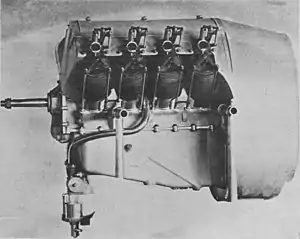| 70 hp/Type WB | |
|---|---|
 | |
| Type | Air-cooled V-8 piston engine |
| National origin | France |
| Manufacturer | Renault Rolls Royce Wolseley Motors Airco |
| First run | 1910 |
| Major applications | Farman MF.7 Royal Aircraft Factory B.E.2 |
| Number built | 1,200 (France) 230 (United Kingdom) |
| Developed from | Renault 50/60 hp |
| Developed into | Renault 80 hp Renault 90 hp RAF 1 |
The Renault 70 hp, (8Ab , 8C) was a French V-8 aero engine that first ran in 1910. The type powered many early military aircraft including the Farman MF.7 Longhorn and the Royal Aircraft Factory B.E.2. In addition to French production, these engines were also built in the United Kingdom[1] and equipped the majority of British aircraft sent to France at the start of WW1.[2]
Design and development
As with other Renault air cooled V-8s, the engine had an early form of reduction gearing where the propeller was fixed to the end of the camshaft and turned at half engine speed. Since the engine turned twice as fast as the propeller, it acted as a flywheel removing the need for any additional counterweights.[1] Engines intended for pusher aircraft were fitted with a centrifugal blower which fed cooling air over the large finned cast iron cylinders.
Compared to contemporary air cooled rotary engines built by Gnome, the 70 hp Renault had a worse power to weight ratio but better fuel economy.[3] Aircraft powered by the Renault 70 hp set distance and duration records in 1912.[1]
The first military orders were placed in 1911 with 81 engines delivered to the French army for use in Farman observation aircraft. In 1912 Farman aircraft powered by the Renault 70 hp equipped two out of the five French squadrons.[1]
In the UK the 70 hp air cooled V8 model was manufactured by Renault’s UK subsidiary and their licensees; Rolls Royce, Wolseley and Airco. Renault refused to sell licenses to German firms in the years before WW1.[1]
Variants
Data from Wolseley Motors's 1917 instruction manual. Weights shown include flywheel, exhaust branches, cowl and propeller boss.[4]
Type W.B - Version with internal lube oil pump. Dry weight: 440 lb (200 kg)
Type W.C - Version with external lube oil pump. Dry weight: 440 lb (200 kg)
Both the W.B and W.C variants were available for pusher (propeller at front) and tractor (propeller at back) aircraft. Engines fitted to tractor aircraft had a cowl scoop which directed part of the propellers air steam across the cylinders. Engines fitted to pusher aircraft were equipped with a back mounted (opposite end from prop) centrifugal blower. The blower added an extra 50 lb (22.7 kg) of weight and consumed 4 hp (3.0 kW).
Type W.X - 75 hp variant. Outwardly almost identical to the 70 hp models but with a larger 100mm cylinder bore and redesigned connecting rods. The connecting rods used the same side by side layout as the 70 hp model but had a two stud design and were interchangeable between left and right cylinder banks. Available in tractor configuration only. Dry weight: 455 lb (206 kg)
Applications
Specifications (70 hp)
Data from Lumsden[5] and Angle.[6] Note: Figures are for British built W.B variant designed to be mounted in tractor configuration.
General characteristics
- Type: Inline air–cooled, upright, 90-degree, V-8 piston engine
- Bore: 3.78 in (96 mm)
- Stroke: 4.72 in (120 mm)
- Displacement: 423.76 cu in (7 L)
- Length: 45.5 in (1,156 mm)
- Width: 29.8 in (757 mm)
- Height: 32.8 in (833 mm)
- Dry weight: 396 lb (180 kg)
Components
- Valvetrain: Single overhead exhaust valve, single side inlet valve per cylinder.Although this valve arrangement is cited as "one side and one overhead valve," both valves are situated in a lateral pocket from/to which gases flow. Therefore both valves are "side valves" one on top of this lateral pocket and one on its bottom. There are no valves on the combustion chamber or on the overhead position.
- Fuel system: Single carburettor
- Fuel type: 40–50 octane petrol
- Cooling system: Air-cooled
- Reduction gear: 0.5:1, left hand tractor (there is no reduction gear as such; The reduction is achieved by mounting the propeller on the camshaft).
Performance
- Power output: 70 hp (52 kW) at 1,750 rpm
- Specific power: 0.17 hp/cu in (7.4 kW/L)
- Compression ratio: 4.12:1
- Fuel consumption: 7.25 gallon/hr (27.4 L/hr)
- Specific fuel consumption: 0.64 lb/(hp⋅h) (0.39 kg/kWh)
- Oil consumption: 6.5 pints/hr (3 L/hr)
- Power-to-weight ratio: 0.18 hp/lb (0.28 kW/kg)
See also
Related lists
References
- 1 2 3 4 5 Hartmann, Gerard (2005). "Les moteurs d'aviation Renault" [Renault aviation engines] (PDF) (in French). Retrieved 10 December 2023.
- ↑ Boyne, Walter J (July 2011). "The Influence of Airpower on the Marne". Air Force Magazine. United States. p. 71. ISSN 1943-4782.
- ↑ Laux, James M (March 1980). "Gnome et Rhône - An Aviation Engine Firm in the First World War: Le Rhône". Aerospace Historian. Vol. 27, no. 1. Air Force Historical Foundation. p. 19-26.
- ↑ "Instruction Manual for Wolseley Aero Engines (Wolseley-Renault Types)" (Document). United Kingdom: Wolseley Motors. 1917.
- ↑ Lumsden, Alec (2002). British Piston Engines and their Aircraft. Airlife Publishing. p. 180. ISBN 1853102946.
- ↑ Angle, Glenn D. (1921). Airplane Engine Encyclopedia. Dayton, Ohio: THE OTTERBEIN PRESS. p. 413.
External links
- Photo "Flymotor Type 70 hk Renault" (side view), Norsk Luftfartsmuseum
- Photo "Flymotor Type 70 hk Renault" (front view), Norsk Luftfartsmuseum